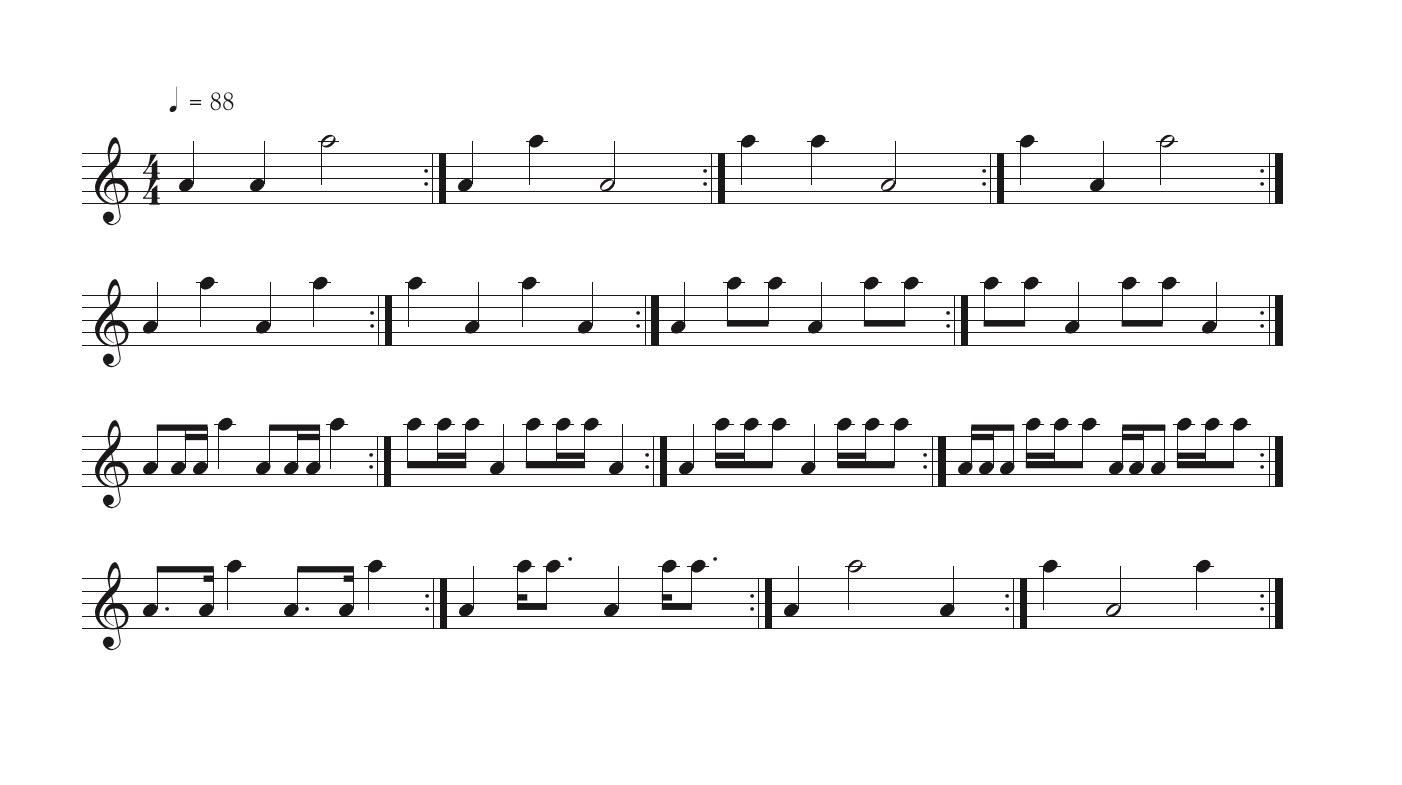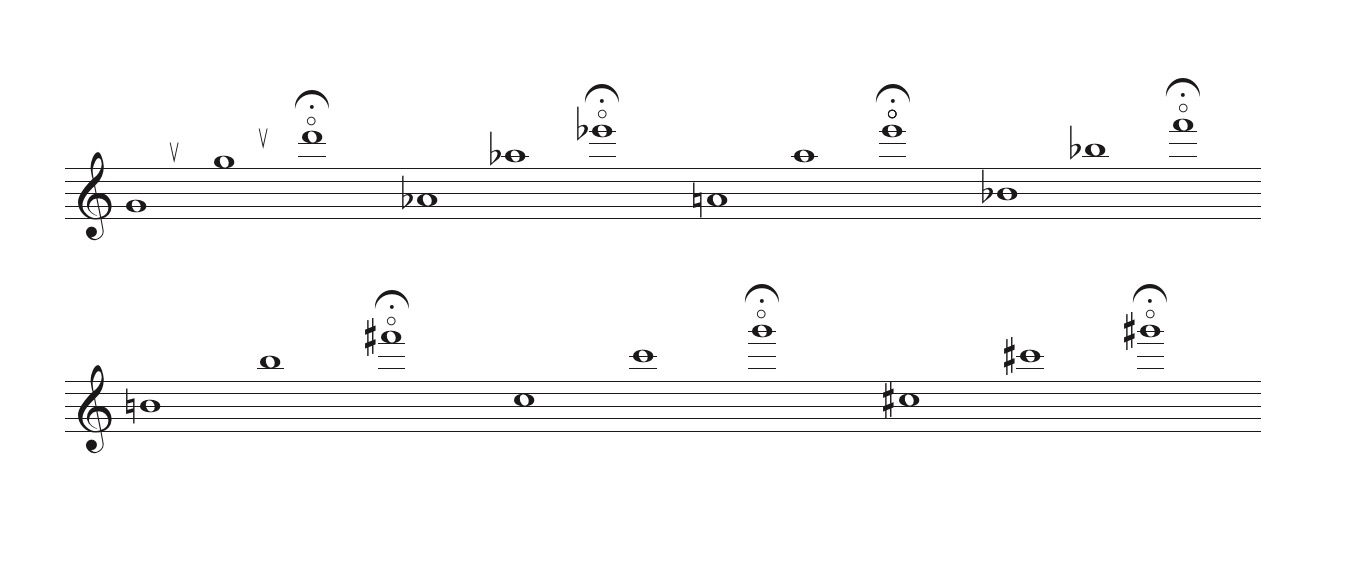This pause has given us time to focus on the basic fundamentals of flute performance. If there is one thing that improves the sound and embouchure facility, it is practicing harmonics. Harmonics are produced by fingering a fundamental note and then overblowing and/or changing the angle of the air with the embouchure to produce a higher note.
Headjoint First
Take the headjoint and hold it at each end with the thumb and index finger. Keeping the embouchure hole level, blow a low A. Take a breath and then increase the air speed to play an upper A (it will be out of tune). Practice this several times to build confidence in producing either the lower or upper A successfully on demand.
Agility
Practice the following exercises to gain agility and flexibility using the TU attack. Repeat each measure 4 to 10 times. Notice the aperture (opening in the lips) gets smaller for the upper A and larger for the lower A. Use a mirror to check this. Create more exercises utilizing less familiar rhythmic patterns. If you have a book of rhythms, practice playing them using the headjoint notes.

Slurring
Repeat the first six measures above slurring from the low A to high A or the opposite. Keep the headjoint still and do not roll in or out. Let the embouchure do the work. The embouchure hole remains level throughout the exercises.
Even Air
Play the low A with the tuner, not worrying about the pitch, but concentrating on keeping the needle still. Once you can keep the needle still without quivering for eight or more seconds, you are gaining control of the air stream. Playing with even air is the basis for developing a beautiful sound. Repeat using the high A. If the tone lacks focus, standing with the left foot in front and the right foot in back in the 12:00 and 2:30 position, aim the air towards your left big toe. Do not roll the flute in or lower the head. The head should be positioned at the bottom of a very small nod.
Articulation
With the tuner, play a lower A beginning the note with TU. Watch to see if the beginning of the note goes shaper and then settles into the needle being still. Most flutists see a spike of sharpness at the beginning of the note. The goal is to be perfectly in tune without the spike. If there is a spike, practice starting the note with a breath attack (tongueless attack). It is easier to control the pitch with the breath attack than with the TU attack. Practice until there is no spike in the HAH attack and then apply what you have learned to the TU attack. And eventually to the K attack.
Once the pitch is under control, practice for tonguing endurance and speed. Play four sixteenth notes as fast as you can. Then take a breath and tongue eight sixteenth notes as fast as you can. Each time add four sixteenth notes until you can tongue a string of 16 sixteenth notes fast. The goal for single tonguing should be about four sixteenth notes to 144 on the metronome. Repeat with the K syllable and then TK.
Vibrato
Vibrato is produced in the vocal folds. Play HAH, HAH, HAH, rest on the low A as softly as possible. These are called throat staccatos or breath attacks. Do not move your jaw, chest or abdomen. Once you can play a string of the throat staccatos, simply slur the HAH, HAH, HAH, followed by a rest many times. Repeat on the upper A. Now alternate slurring from low A to high A, placing 2, 3, 4, 5, or 6 vibrato cycles on each note.

Add the Body to the Headjoint
Align the headjoint carefully. The center of the embouchure hole aligns with the center of the right-hand keys. Place the right hand on the barrel and play the following three notes from a low G fingering. Notice that a circle is placed above the note that to indicate that the note is played with a harmonic fingering. Take a sip breath between each note, holding the last note as long as possible. If you can taper on the last note, bravo.

Once you have mastered finding these pitches, slur each grouping of three notes. The first note is the fundamental or partial one. The next is partial two and the last is partial three. Eventually make up different patterns to slur such as: 3, 2, 1; 2, 3, 2, 3; 1, 3, 2 etc. Play with vibrato when doing this exercise. (See Patricia George’s Extras for several pages of melodies to be played with the right-hand on the barrel.)
Add the Footjoint
The harmonic series is a group of pitches that may be produced from a fundamental. When playing low C, it is possible to produce six to eight pitches above the fundamental. Exactly how many can be produced will depend on the individual flute. The intervallic (distance between two notes) relationship from one note or partial to the next is in this order: Perfect Octave, Perfect Fifth, Perfect Fourth, Major Third, Minor Third, Minor Third, and Major Second.

Play low C and then overblow to find the second octave C. Continue on with the G, C, E, G, Bb, and C tonguing each with a small rest in between each note. The goal of this first exercise is to find all the notes. It is rather like playing a bugle. Repeat on low C#, D, Eb, E, F, and F#. As the fundamental gets higher there will be fewer of the upper partials to sound.
Next practice slurring from one partial to the next as in the following exercise.

Work on each group of two notes making the slur sound as easy as possible. When practicing this exercise, the aperture will get smaller with each higher note. Some of these pairings respond better than others. Learning where the challenging places are helps you to learn about the idiosyncrasies of your individual flute.
To apply what you have achieved add in the regularly fingered note after the harmonic note. This will help develop ring in your sound. Once again, practicing harmonics with vibrato offers a huge payoff in tone work.

Like the exercise above, practice playing the harmonics in different orders. Any work you do with this exercise offers huge benefits for the future.
The goal is to memorize the harmonic series starting on any fundamental note. This will take some time but is worth the effort.
For fun play simple melodies using the third harmonic partial. (See Patricia George’s Extras for several more melodies.)

There is no one way to practice harmonics. Be creative and explore the possibilities. Incorporate harmonic work into your daily warmup. Playing them only takes a few minutes but the results save you many hours of practice.






